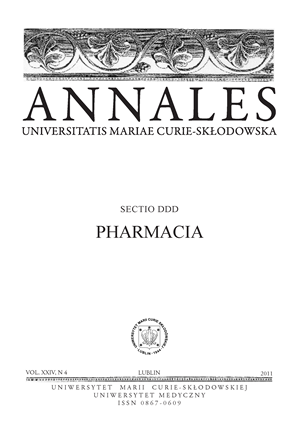The effect of protocatechuic acid on the tongue mucosa in rats exposed to n-nitrosomethylbenzylamine
DOI:
https://doi.org/10.12923/Keywords:
protocatechuic acid, N-nitrosomethylbenzylamine, experimental carcinogenesis, tongue, ratAbstract
The effect of natural plant-derived phenol – protocatechuic acid on lesions induced by carcinogen – N-nitrosomethylbenzylamine in the squamous epithelium of the tongue was investigated in rats. Carcinogen was applied for 3-8 weeks of the experiment (0.5 mg/kg/dose; 3 doses/week). Protocatechuic acid was administered with a daily diet in two doses 1000 or 2000 ppm for first 7 or 24 weeks of the experiment. Incidence and multiplicity of gross lesions on the dorsal surface of the tongue was the highest in rats exposed exclusively to carcinogen. Multiplicity of lesions was significantly lower in the group fed with diet containing protocatechuic acid in higher dose for the whole experiment. The most frequent lesion in the microscopic examination was hyperplasia of the squamous epithelium. Dysplasia and papillomas were rarely seen, while carcinomas were not observed. Chemoprevention activity of protocatechiuc acid in applied experimental model was confirmed.
References
1. Block G, Patterson B, Subar A: Fruit, vegetables, and cancer prevention: a review of the epidemiological evidence. Nutr. Cancer, 18, 1, 1992.
2. Hirose Y et al.: Chemoprevention of urinary bladder carcinogenesis by the natural phenolic compound protocatechuic acid in rats. Carcinogenesis, 16, 2337, 1995.
3. Kanojia D, Vaidya MM: 4-nitroquinoline-1-oxide induced experimental oral carcinogenesis. Oral Oncol., 42, 655, 2006.
4. Neville BW et al., editors (2009). Oral and maxillofacial pathology. St. Louis: Saunders Elsevier.
5. Pacheco-Palencia LA et al.: Chemical composition, antioxidant properties, and thermal stability of a phytochemical enriched oil from Acai (Euterpe oleracea Mart.). J. Agric. Food Chem., 56, 4631, 2008.
6. Podlodowska J et al.: Epidemiologia i czynniki ryzyka raka jamy ustnej. Pol. Merkur. Lekarski, 2011 (in press).
7. Srinivasan P et al.: Chemopreventive and therapeutic modulation of green tea polyphenols on drug metabolizing enzymes in 4-Nitroquinoline 1-oxide induced oral cancer. Chem. Biol. Interact., 172, 224, 2008.
8. Sun Z et al.: Chemoprevention of oral cancer in animal models, and effect on leukoplakias in human patients with ZengShengPing, a mixture of medicinal herbs. Oral Oncol., 46, 105, 2010.
9. Suzuki R et al.: Dietary protocatechuic acid during the progression phase exerts chemopreventive effects on chemically induced rat tongue carcinogenesis. Asian Pac. J. Cancer Prev., 4, 319, 2003.
10. Szumiło J (2007). Wpływ resweratrolu i kwasu protokatechowego na rozwój nowotworów płaskonabłonkowych przełyku u szczura, indukowanych przez N-nitrozometylobenzyloaminę. Rozprawa Habilitacyjna. Lublin: Uniwersytet Medyczny w Lublinie.
11. Szumiło J et al.: Chemoprewencja nowotworów płaskonabłonkowych jamy ustnej – badania kliniczne i doświadczalne. Pol. Merkur. Lekarski, 2011 (in press).
12. Szumiło J: Kwas protokatechowy w prewencji nowotworów. Post. Hig. Med. Dosw., 59, 608, 2005.
13. Tanaka T et al.: Chemoprevention of 4-nitroquinoline 1-oxide-induced oral carcinogenesis by dietary protocatechuic acid during initiation and postinitiation phases. Cancer Res., 54, 2359, 1994.
14. Tanaka T et al.: Chemoprevention of colonic carcinogenesis by the natural product of a simple phenolic compound protocatechuic acid: suppressing effect on tumor development and biomarkers expression of colon tumorogenesis. Cancer Res., 53, 3908, 1993.
15. Tanaka T et al.: Chemoprevention of diethylnitrosamine-induced hepatocarcinogenesis by a simple phenolic acid protocatechuic acid in rats. Cancer Res., 53, 2775, 1993.
16. The Oral Cancer Foundation (2011): http://oralcancerfoundation.org/ (last access; September 12, 2011).
Downloads
Published
Issue
Section
License
Copyright (c) 2011 Authors

This work is licensed under a Creative Commons Attribution-NonCommercial-NoDerivatives 3.0 Unported License.


